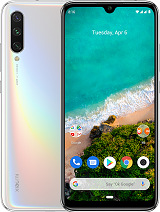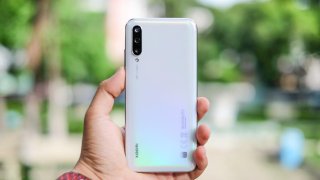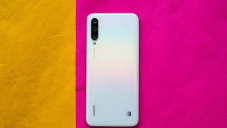Xiaomi Mi A3
$168 | 14999
- 6.09" 720x1560 pixels
- 48MP 2160p
- 4/6GB RAM Snapdragon 665
- 4030mAh Li-Po
Phone Finder
- Acer alcatel Allview Amazon Amoi Apple Archos Asus AT&T Benefon BenQ BenQ-Siemens Bird BlackBerry Blackview BLU Bosch BQ Casio Cat Celkon Chea Coolpad Cubot Dell Doogee Emporia Energizer Ericsson Eten Fairphone Fujitsu Siemens Garmin-Asus Gigabyte Gionee Google Haier HMD Honor HP HTC Huawei i-mate i-mobile Icemobile Infinix Innostream iNQ Intex itel Jolla Karbonn Kyocera Lava LeEco Lenovo LG Maxon Maxwest Meizu Micromax Microsoft Mitac Mitsubishi Modu Motorola MWg NEC Neonode NIU Nokia Nothing Nvidia O2 OnePlus Oppo Orange Oscal Oukitel Palm Panasonic Pantech Parla Philips Plum Posh Prestigio QMobile Qtek Razer Realme Sagem Samsung Sendo Sewon Sharp Siemens Sonim Sony Sony Ericsson Spice T-Mobile TCL Tecno Tel.Me. Telit Thuraya Toshiba Ulefone Umidigi Unnecto Vertu verykool vivo VK Mobile Vodafone Wiko WND XCute Xiaomi XOLO Yezz Yota YU ZTE
Xiaomi Mi A3 Summary
Xiaomi has followed a similar formula when it launched an Android One phone. It uses a version sold in the Chinese market, replacing MIUI with Google's stock Android One OS and selling it globally. The Mi A1 was renamed from Mi 5X, Mi A2 is "recycled" from Mi 6X, and this year Mi A3 is the Android One version of the Mi CC9e in the Chinese market.
Compared to last year's Mi A2, the Mi A3 has undergone many positive changes: a more youthful glass back design, an AMOLED panel, a larger battery, an upgraded processor and more rear cameras of which the main camera uses a 48MP sensor of Sony, quite popular in the mid-range segment. In addition, Xiaomi also added a memory card slot and a 3.5mm headphone jack, two missing details that made Xiaomi many users complain about on the Mi A2. The only significant cons in this product is that the screen is reduced to HD resolution, not Full-HD like the previous generation.
Display
Compared to the old Mi A2 generation, the screen of Mi A3 has two major changes, one is good and one is bad. The transition to AMOLED panel is considered a plus point of the product, but HD + resolution with a pixel density of 268 PPI caught many people off guard. This is a relatively low resolution, making the app icons and text appear not sharp, smooth. This difference is noticeable when compared to the same sized screen with Full-HD resolution.
It is not clear why Xiaomi uses HD resolution on Mi A3 but this is the device that it advertises as a cheap gaming smartphone, so the low resolution will help the phone have a smoother gaming performance. In addition, an additional benefit of HD resolution is significantly improved battery life.
In terms of display quality, the display has the strengths of the AMOLED panel, which are bright colors, high contrast, and wide viewing angle. In the outdoors, the screen can be used comfortably in the shade or when it is cloudy, but in direct sunlight, it is still a bit difficult to see because the maximum brightness is not high.
Performance
Xiaomi Mi A3 uses the Snapdragon 665 processor, an upgrade over the Snapdragon 660 chip on last year's Mi A2. In terms of performance, the two chips are similar. The Snapdragon 665 is upgraded is based on the 11nm process, which is more energy-efficient than the 14nm process on the Snapdragon 660 and the chipset also offers better image processing capabilities.
Specifically, Snapdragon 665 has 8 CPU cores divided into two clusters, a cluster of high-performance quad-core Kryo 260 Gold (similar to Cortex-A73) clocked at 2GHz and the energy-efficient quad-core cluster of Kryo 260 Silver (similar to Cortex A53) 1.8Ghz clock speed. Compared to Snapdragon 660, the high-performance quad-core cluster of Snapdragon 665 has a lower clock speed by 200MHz.
The GPU on the Snapdragon 665 is the Adreno 610, which is no more powerful than the Adreno 512 on the Snapdragon 660 chip but saves more than 20% battery life, according to Qualcomm.
On performance measurement apps, the Mi A3 has a similar performace to the Mi A2 and the Redmi Note 7, both of which use the same Snapdragon 660. However, with the advantage of a lower HD resolution, the Mi A3 can handle apps smoother.
With gaming, Mi A3 can run not too heavy games with average graphics. As for heavy games like PUBG Mobile, the device can be stable at average fps. We tested it with GameBench with some familiar games on the Mi A3. The results showed that the device played smoothly at a high fps of 60 and was stable with moderate graphics games such as Dead Trigger 2. However, with heavy graphics game PUBG Mobile, the device only achieves 26-30 fps, not too high fps but high stability.
Dead Trigger 2 shooter does not trouble Mi A3: 60 fps and 82% stability. With PUBG Mobile, the Mi A3 is really struggling as the game ran only ran at 30 fps when reducing the graphics to the lowest level.
The battery is the point that Mi A3 has a strong upgrade compared to the old generation. It has a 4,030mAh battery, 35% larger than the 3,000mAh battery on Mi A2. Meanwhile, the device has a low screen resolution and Snapdragon 665 chip on the 11nm process to save power. The combination of these three details has helped this phone have an extremely impressive battery life, much higher than smartphones in the mid-range segment today.
The Mi A3 supports 18W Quick Charge 3, but to save money, the company only offers a regular 10W charger. To get the most out of your charging speed, you need to buy a quick charger. With 18W fast charger, the device takes about 1 hour 40 minutes to fully charge (30 minutes to charge 45%), while the bundled charger takes about 2.5 hours (30 minutes to charge 27%).
Camera
Following the trend, this year's Mi A3 also uses a cluster of 3 rear cameras including the main camera using Sony's IMX582 sensor, 8MP ultra-wide-angle camera, and a 2MP camera to support portrait photography. On the front, the device has a 32MP camera. Sony's 48MP camera is now very popular in the mid-range segment. Even Samsung has recently used the IXM582 for the Galaxy A50s, not using the 48MP ISOCELL GM2 sensor developed by Samsung itself.
Regarding the camera app, Xiaomi has brought the familiar MIUI camera app to Mi A3, not the default Google camera app. This application fully supports the familiar shooting features on the phone today such as automatic HDR, AI, portrait, night, panoramic, short video ... The normal camera, wide-angle, and 2X digital zoom can be switched easily on the capture interface.
The quality of photos taken from the 48MP camera, ultra-wide-angle camera, portrait camera, or combining the main camera with the 2MP camera and the selfie photos from the 32MP camera of Mi A3 have similarities compared to recent mid-range smartphones. It can be said that the difference in cameras between mid-range smartphones is now quite small.
In bright enough conditions, the main camera of Mi A3 captures a lot of detail, natural colors, and good contrast in bright enough conditions.
In low light, the 48MP camera also gives good images, natural colors, less noise, and sharpness. Night mode improves the overall image quality, especially in dark areas. But similar to the recent Redmi Note 8, Mi A3's night mode improves the details on the photo to a moderate level, not as impressive as the other phones. Therefore, photos in night mode are sharper but still look natural.
Xiaomi Mi A3 Full Specifications
- Dollas $168 Buy in Flipkart >
- Rupee ₹14999 Buy in Flipkart >
- Technology GSM / HSPA / LTE
- 2G bands GSM 850 / 900 / 1800 / 1900 - SIM 1 & SIM 2
- 3G bands HSDPA 850 / 900 / 1700 / 1900 / 2100
- 4G bands 1, 2, 3, 4, 5, 7, 8, 20, 28, 38, 40
- Speed HSPA 42.2/5.76 Mbps, LTE-A (2CA) Cat6 400/50 Mbps
- Announced 2019, July
- Status Available. Released 2019, July
- Dimensions 153.5 x 71.9 x 8.5 mm (6.04 x 2.83 x 0.33 in)
- Weight 173.8 g (6.14 oz)
- Build Glass front (Gorilla Glass 5), glass back (Gorilla Glass 5), plastic frame
- SIM Hybrid Dual SIM (Nano-SIM, dual stand-by)
- Type Super AMOLED capacitive touchscreen, 16M colors
- Size 6.09 inches, 91.0 cm2 (~82.5% screen-to-body ratio)
- Resolution 720 x 1560 pixels, 19.5:9 ratio (~282 ppi density)
- Protection Corning Gorilla Glass 5
- OS Android 9.0 (Pie), upgradable to Android 10.0; Android One
- Chipset Qualcomm SDM665 Snapdragon 665 (11 nm)
- CPU Octa-core (4x2.0 GHz Kryo 260 Gold & 4x1.8 GHz Kryo 260 Silver)
- GPU Adreno 610
- Card slot microSDXC (uses shared SIM slot)
- Internal 64GB 4GB RAM, 128GB 4GB RAM, 128GB 6GB RAM
- UFS 3.1
- Modules 48 MP, f/1.8, (wide), 1/2.0", 0.8µm, PDAF 8 MP, f/2.2, 13mm (ultrawide), 1/4.0", 1.12µm 2 MP, f/2.4, (depth)
- Features LED flash, HDR, panorama
- Video 2160p@30fps, 1080p@30/60/120fps
- Modules 32 MP, f/2.0, 26mm (wide), 1/2.8", 0.8µm
- Features HDR
- Video 1080p@30fps
- Loudspeaker Yes
- 3.5mm jack Yes
- WLAN Wi-Fi 802.11 a/b/g/n/ac, dual-band, Wi-Fi Direct, hotspot
- Bluetooth 5.0, A2DP, LE, aptX HD
- GPS Yes, with A-GPS, GLONASS, BDS
- Infrared port Yes
- Radio FM radio
- USB 2.0, Type-C 1.0 reversible connector
- Sensors Fingerprint (under display, optical), accelerometer, gyro, proximity, compass
- Non-removable Li-Po 4030 mAh battery
- Charging Fast charging 18W Quick Charge 3
- Colors Kind of Gray, Not just Blue, More than White
- Models M1906F9SH, M1906F9SI
- SAR 0.53 W/kg (head) 0.72 W/kg (body)
- SAR EU 0.30 W/kg (head) 1.10 W/kg (body)
- Performance Basemark OS II 2.0: 2345Basemark X: 17948
- Display Contrast ratio: Infinite (nominal)
- Camera Photo
- Loudspeaker Voice 74dB / Noise 74dB / Ring 81dB
- Audio quality Noise -93.7dB / Crosstalk -93.0dB
- Battery life Endurance rating 101h
Xiaomi Mi A3 News

Mobile - Feb 16, 2021
Xiaomi Mi A3: Specifications, Price In India, Review - All You Need

Mobile - Aug 07, 2020
Xiaomi Mi A4 Not Coming As Xiaomi Ditches Its Android One Project

Mobile - Jul 28, 2020
10 Best Xiaomi Phone 2020 In India From Budget To High-End Segments

Mobile - Aug 22, 2019
Xiaomi Mi A3 Goes Official in India For A Starting Price Of Rs. 12,999

Mobile - Aug 19, 2019











